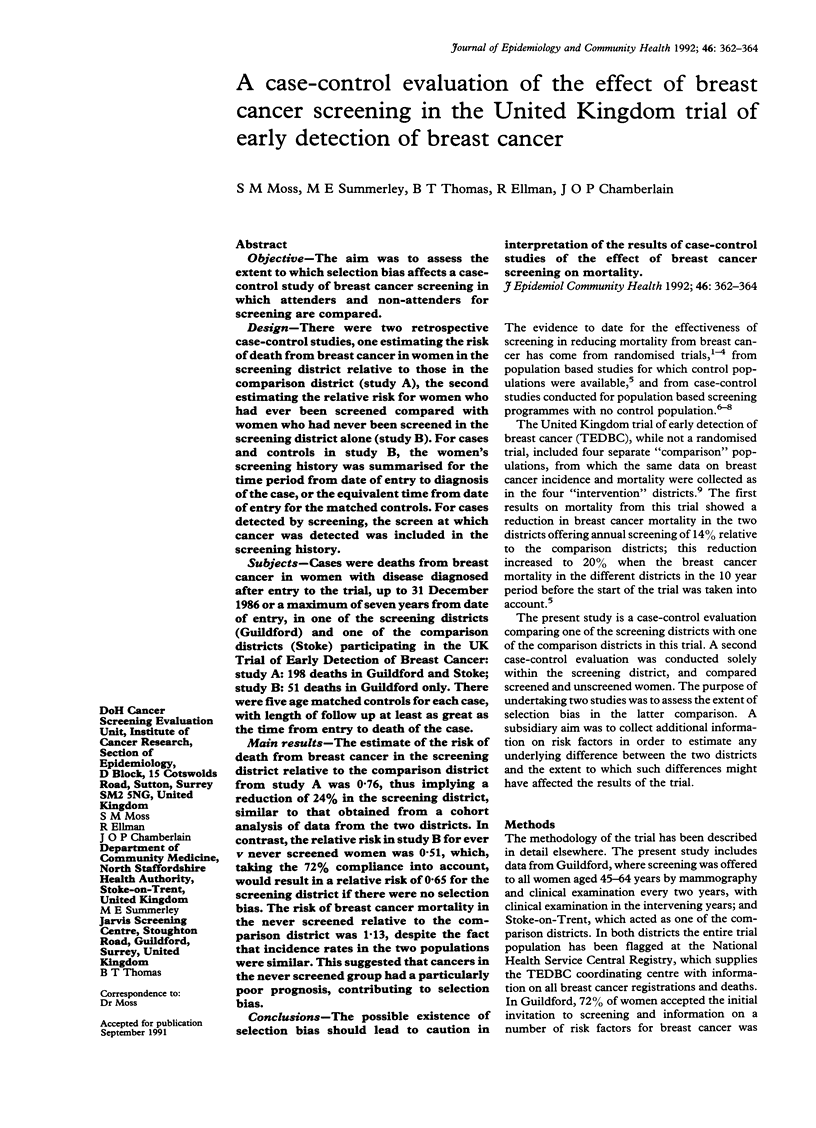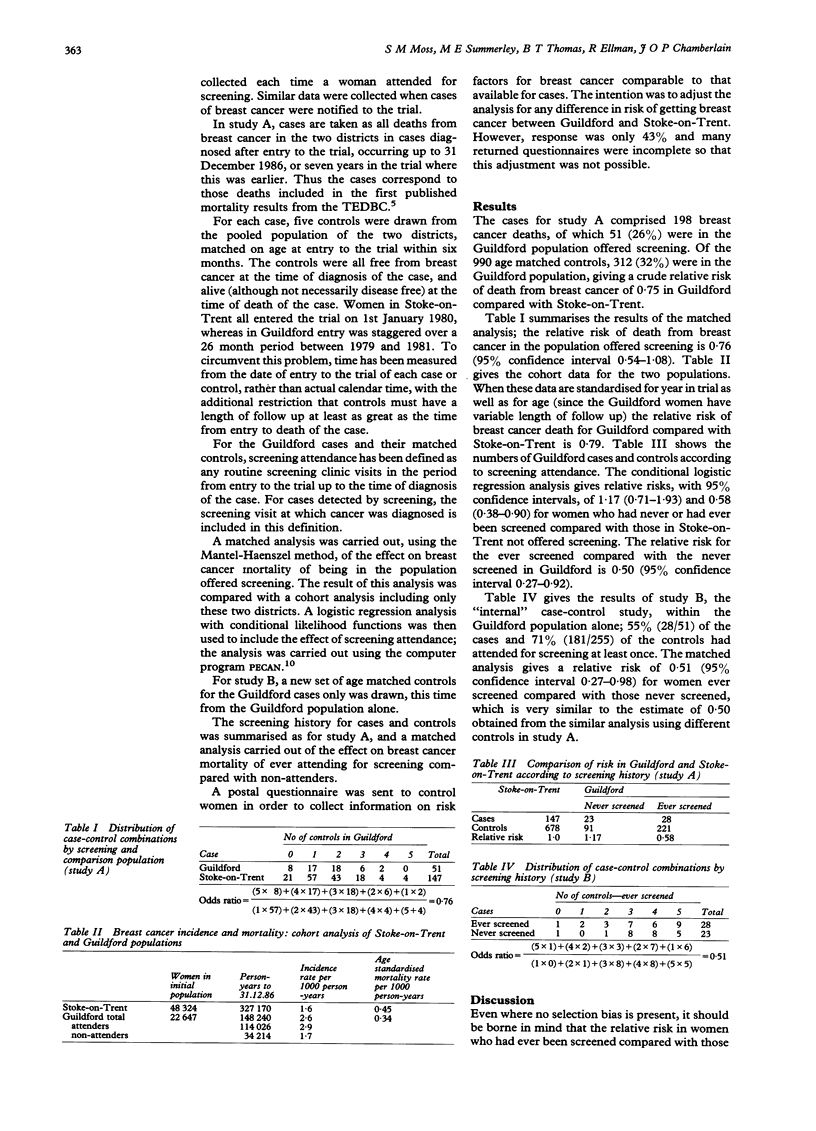Abstract
OBJECTIVE--The aim was to assess the extent to which selection bias affects a case-control study of breast cancer screening in which attenders and non-attenders for screening are compared. DESIGN--There were two retrospective case-control studies, one estimating the risk of death from breast cancer in women in the screening district relative to those in the comparison district (study A), the second estimating the relative risk for women who had ever been screened compared with women who had never been screened in the screening district alone (study B). For cases and controls in study B, the women's screening history was summarised for the time period from date of entry to diagnosis of the case, or the equivalent time from date of entry for the matched controls. For cases detected by screening, the screen at which cancer was detected was included in the screening history. SUBJECTS--Cases were deaths from breast cancer in women with disease diagnosed after entry to the trial, up to 31 December 1986 or a maximum of seven years from date of entry, in one of the screening districts (Guildford) and one of the comparison districts (Stoke) participating in the UK Trial of Early Detection of Breast Cancer: study A: 198 deaths in Guildford and Stoke; study B: 51 deaths in Guildford only. There were five age matched controls for each case, with length of follow up at least as great as the time from entry to death of the case. MAIN RESULTS--The estimate of the risk of death from breast cancer in the screening district relative to the comparison district from study A was 0.76, thus implying a reduction of 24% in the screening district, similar to that obtained from a cohort analysis of data from the two districts. In contrast, the relative risk in study B for ever v never screened women was 0.51, which, taking the 72% compliance into account, would result in a relative risk of 0.65 for the screening district if there were no selection bias. The risk of breast cancer mortality in the never screened relative to the comparison district was 1.13, despite the fact that incidence rates in the two populations were similar. This suggested that cancers in the never screened group had a particularly poor prognosis, contributing to selection bias. CONCLUSIONS--The possible existence of selection bias should lead to caution in interpretation of the results of case-control studies of the effect of breast cancer screening on mortality.
Full text
PDF


Selected References
These references are in PubMed. This may not be the complete list of references from this article.
- Andersson I., Aspegren K., Janzon L., Landberg T., Lindholm K., Linell F., Ljungberg O., Ranstam J., Sigfússon B. Mammographic screening and mortality from breast cancer: the Malmö mammographic screening trial. BMJ. 1988 Oct 15;297(6654):943–948. doi: 10.1136/bmj.297.6654.943. [DOI] [PMC free article] [PubMed] [Google Scholar]
- Collette H. J., Day N. E., Rombach J. J., de Waard F. Evaluation of screening for breast cancer in a non-randomised study (the DOM project) by means of a case-control study. Lancet. 1984 Jun 2;1(8388):1224–1226. doi: 10.1016/s0140-6736(84)91704-5. [DOI] [PubMed] [Google Scholar]
- Gullberg B., Andersson I., Janzon L., Ranstam J. Screening mammography. Lancet. 1991 Jan 26;337(8735):244–244. doi: 10.1016/0140-6736(91)92216-o. [DOI] [PubMed] [Google Scholar]
- Locker A. P., Caseldine J., Mitchell A. K., Blamey R. W., Roebuck E. J., Elston C. W. Results from a seven-year programme of breast self-examination in 89,010 women. Br J Cancer. 1989 Sep;60(3):401–405. doi: 10.1038/bjc.1989.294. [DOI] [PMC free article] [PubMed] [Google Scholar]
- Palli D., Del Turco M. R., Buiatti E., Carli S., Ciatto S., Toscani L., Maltoni G. A case-control study of the efficacy of a non-randomized breast cancer screening program in Florence (Italy). Int J Cancer. 1986 Oct 15;38(4):501–504. doi: 10.1002/ijc.2910380408. [DOI] [PubMed] [Google Scholar]
- Roberts M. M., Alexander F. E., Anderson T. J., Chetty U., Donnan P. T., Forrest P., Hepburn W., Huggins A., Kirkpatrick A. E., Lamb J. Edinburgh trial of screening for breast cancer: mortality at seven years. Lancet. 1990 Feb 3;335(8684):241–246. doi: 10.1016/0140-6736(90)90066-e. [DOI] [PubMed] [Google Scholar]
- Shapiro S., Venet W., Strax P., Venet L., Roeser R. Ten- to fourteen-year effect of screening on breast cancer mortality. J Natl Cancer Inst. 1982 Aug;69(2):349–355. [PubMed] [Google Scholar]
- Tabár L., Fagerberg C. J., Gad A., Baldetorp L., Holmberg L. H., Gröntoft O., Ljungquist U., Lundström B., Månson J. C., Eklund G. Reduction in mortality from breast cancer after mass screening with mammography. Randomised trial from the Breast Cancer Screening Working Group of the Swedish National Board of Health and Welfare. Lancet. 1985 Apr 13;1(8433):829–832. doi: 10.1016/s0140-6736(85)92204-4. [DOI] [PubMed] [Google Scholar]
- Verbeek A. L., Hendriks J. H., Holland R., Mravunac M., Sturmans F., Day N. E. Reduction of breast cancer mortality through mass screening with modern mammography. First results of the Nijmegen project, 1975-1981. Lancet. 1984 Jun 2;1(8388):1222–1224. doi: 10.1016/s0140-6736(84)91703-3. [DOI] [PubMed] [Google Scholar]
- Verbeek A. L., Hendriks J. H., Holland R., Mravunac M., Sturmans F. Mammographic screening and breast cancer mortality: age-specific effects in Nijmegen Project, 1975-82. Lancet. 1985 Apr 13;1(8433):865–866. doi: 10.1016/s0140-6736(85)92223-8. [DOI] [PubMed] [Google Scholar]


